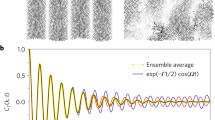Abstract
IN a recent note E. Gross has found that the Debye elastic heat waves also give rise to modified scattering in liquids.1 The fact that electromagnetic waves are modified by the elastic heat waves shows that the origin of the latter in liquids is also electrical and akin to lattice oscillations in crystals. In order to explain facts connected with X-ray diffraction in liquids, it was found that a liquid has to be regarded as a broken up crystal in which there is thermodynainic equilibrium between heat motion and forces of crystal formation.2 It was seen both theoretically and from observations on X-ray diffraction that there is a maximum in the molecular arrangements in liquids corresponding to the structure of the substance in the crystal state. It is evident that this partial crystallinity of liquids is responsible for the modified scattering found by Gross. It is, therefore, expected that those liquids which produce sharp diffraction effects should also produce sharp modified lines, and it will be interesting to see whether that comes out true.
Similar content being viewed by others
References
NATURE, Aug. 9, 1930, p. 201.
Ind. Jour. Phys., vol. 4, pt. 7, pp. 541–556.
NATURE, Oct. 18, 1930, p. 603.
Author information
Authors and Affiliations
Rights and permissions
About this article
Cite this article
BANERJEE, K. Relation of the Liquid to the Crystalline State. Nature 127, 92–93 (1931). https://doi.org/10.1038/127092c0
Issue Date:
DOI: https://doi.org/10.1038/127092c0
- Springer Nature Limited





